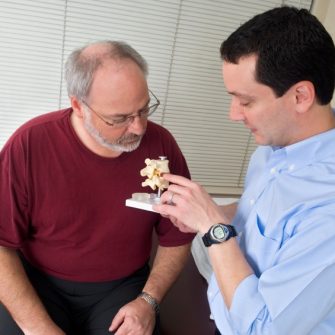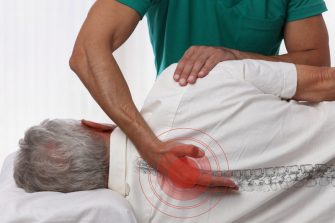Why is Chiropractic Sought Out by Millions of Americans?

Chiropractic has been a healthcare profession for 125 years (1), helping people with back and neck pain, headaches and other types of “neuro-musculoskeletal” pain — while also improving mobility and performance. Today, doctors of chiropractic (DC) provide care in all 50 states, the District of Columbia, Puerto Rico, the U.S. Virgin Islands and other countries, including Portugal, South Africa, Malaysia, Ireland, Canada, Mexico, Great Britain, Switzerland, Australia, New Zealand, Philippines and Japan.
Nearly 36 million individuals in the U.S. each year seek care from a DC, and more than 700 million people each year visit a DC worldwide. Not only are these individuals satisfied with their chiropractic care, but scientific studies have also shown chiropractic adjustments are effective for relieving acute and chronic pain, particularly in the back and neck, while also improving mobility. Chiropractic patients also tend to use fewer over-the-counter (OTC) and prescription painkillers and have an overall improved sense of well-being (2) thanks to continued chiropractic care.
DCs could be the right choice for your health. Like all healthcare decisions, it is important to learn more about the main treatment option performed by DCs, the chiropractic adjustment.
What is a chiropractic adjustment?
 Chiropractic adjustments are a form of spinal manipulative therapy (SMT). An adjustment involves a DC using his or her hands and/or an instrument to apply a controlled force to a joint to restore proper function and mobility. Before delivering an adjustment, the DC needs to learn more about your health and health history. The doctor will ask you about your health concerns, including related symptoms, daily activities, sleep habits, nutrition and any prescription or OTC medications or supplements, and perform a physical exam. The DC will then recommend the best care approach to help you achieve your health goals, which may or may not include the chiropractic adjustment as this treatment may not be right for everyone.
Chiropractic adjustments are a form of spinal manipulative therapy (SMT). An adjustment involves a DC using his or her hands and/or an instrument to apply a controlled force to a joint to restore proper function and mobility. Before delivering an adjustment, the DC needs to learn more about your health and health history. The doctor will ask you about your health concerns, including related symptoms, daily activities, sleep habits, nutrition and any prescription or OTC medications or supplements, and perform a physical exam. The DC will then recommend the best care approach to help you achieve your health goals, which may or may not include the chiropractic adjustment as this treatment may not be right for everyone.
When an adjustment is performed, you may hear popping sounds coming from the area being treated. These sounds, called joint cavitation, are normal and caused by the exchange of gases such as oxygen, nitrogen and carbon dioxide around the joint. After the adjustment, pain relief is often immediate, but can be short lived.
Your DC may recommend following with a treatment regimen including multiple visits to help your body maintain mobility and function. In fact, some patients choose to continue receiving adjustments after pain relief for prevention, but also due to the improved sense of well-being they feel with chiropractic care.
Why get an adjustment?
 Chiropractic adjustments can allow pain relief to occur naturally without the need for OTC medications or prescription painkillers. These medications can pose a significant health risk to yourself and studies have found opioids to be ineffective (3) for chronic pain relief. Chiropractic patients with back and neck pain have been shown to have 55% lower odds of filling an opioid prescription. In addition to less prescriptive painkiller use, more than half (52%) of adults who saw a DC for significant neck or back pain said it was because the DC offered “the most effective treatment for my pain,” a result found by the Gallup-Palmer College of Chiropractic 2018 Annual Report.
Chiropractic adjustments can allow pain relief to occur naturally without the need for OTC medications or prescription painkillers. These medications can pose a significant health risk to yourself and studies have found opioids to be ineffective (3) for chronic pain relief. Chiropractic patients with back and neck pain have been shown to have 55% lower odds of filling an opioid prescription. In addition to less prescriptive painkiller use, more than half (52%) of adults who saw a DC for significant neck or back pain said it was because the DC offered “the most effective treatment for my pain,” a result found by the Gallup-Palmer College of Chiropractic 2018 Annual Report.
Scientific evidence continues to mount for the use of adjustments to relieve low back and other types of musculoskeletal pain. The U.S. Department of Defense recently funded three clinical trials (4) that concluded chiropractic care improves strength and endurance and decreases pain measures for active duty service members with low back pain. As a result of the mounting evidence, several medical societies (5) and other industry organizations have changed their guidelines for managing pain to include spinal manipulation. Leading scientific journals such as The Lancet (6) and the World Health Organization Bulletin (7) have also urged healthcare providers to first consider drug-free pain management therapies, such as chiropractic adjustments, for low back pain.
The increasing evidence that chiropractic care is effective for pain relief is recognized by health insurers, too. These companies are changing their health plan policies because chiropractic adjustments are effective and can lower healthcare costs compared to expensive surgeries, prescriptions and imaging tests. For example, Optum, which is part of UnitedHealth Group (one of the world’s largest private health insurers), reported that it saves more than $1,000 per patient (8) if he or she visits a DC for their low back pain instead of a medical physician specialist. UnitedHealth Group now offers health plans with $0 co-pays (9) for patients who seek care from a DC for their low back pain.
Why are DCs the healthcare practitioner most commonly recommended to provide adjustments?
 DCs receive a minimum of 4,200 hours of classroom, laboratory and clinical internship followed by national board exams, state licensure exams and continuing education focusing specifically on a drug-free, hands-on approach to healthcare that includes patient examination, diagnosis and treatment. Most people are unaware that the typical DC program is equivalent in classroom hours (10) to allopathic and osteopathic medical schools.
DCs receive a minimum of 4,200 hours of classroom, laboratory and clinical internship followed by national board exams, state licensure exams and continuing education focusing specifically on a drug-free, hands-on approach to healthcare that includes patient examination, diagnosis and treatment. Most people are unaware that the typical DC program is equivalent in classroom hours (10) to allopathic and osteopathic medical schools.
A study recently published in JAMA Network (11) found spinal manipulation delivered by physical therapists and doctors of osteopathic medicine, who receive less official training in adjustments than DCs, were not effective for pain relief or physical function in chronic low back pain patients. That study did not include DCs, while other studies of adjustments performed by DCs have found that patients more commonly do experience pain relief (12) and improved function (13).
Additionally, DCs are often focused on more than just pain relief. The chiropractic profession is a holistic healthcare practice concerned with improving overall health and well-being and it is common for patients to experience numerous other benefits in addition to reduced neuro-musculoskeletal pain. A holistic view is also why DCs will recommend a comprehensive care plan that includes exercise, stretching, nutrition and lifestyle changes.
Sources:
1.) History of Chiropractic. World Federation of Chiropractic. Available at: https://www.wfc.org/website/index.php?option=com_content&view=article&id=46&Itemid=109&lang=en
2.) Adams, Jon; Peng, Wenbo; Cramer, Holger; Sundberg, Tobias; Moore, Craig; Amorin-Woods, Lyndon; Sibbritt, David; Lauche, Romy. (2017). The Prevalence, Patterns, and Predictors of Chiropractic Use Among US Adults. Spine. Available at: https://www.ingentaconnect.com/content/wk/brs/2017/00000042/00000023/art00018
3.) Morrone, L.; Scuteri, D.; Rombola, L.; Mizoguchi, H.; Bagetta, G. (2017). Opioids Resistance in Chronic Pain Management. Current Neuropharmacology. Available at: https://www.ncbi.nlm.nih.gov/pmc/articles/PMC5405610/
4.) Military Health System. (2020). Reports to Congress Signed in 2020. Available at: https://www.health.mil/About-MHS/OASDHA/Defense-Health-Agency/Congressional-Relations/Reports-to-Congress
5.) Amir Qaseem, MD, PhD, MHA; Timothy J. Wilt, MD, MPH; Robert M. McLean, MD; Mary Ann Forciea, MD. (2017). Noninvasive Treatments for Acute, Subacute, and Chronic Low Back Pain: A Clinical Practice Guideline f rom the American College of Physicians. Annals of Internal Medicine. Available at: https://www.acpjournals.org/doi/10.7326/M16-2367
6.) Prof Nadine E Foster, DPhil; Prof Johannes R Anema, PhD; Dan Cherkin, PhD; Prof Roger Chou, PhD; Prof Steven P Cohen, MD; Prof Douglas P Gross, PhD; et al. (2018). Prevention and treatment of low back pain: evidence, challenges, and promising directions. The Lancet. Available at: https://www.thelancet.com/journals/lancet/article/PIIS0140-6736(18)30489-6/fulltext
7.) Traeger, A.; Buchbinder, R.; Elshaug, A.; Croft, P.; Maher, C. (2018). Care for low back pain: can health systems deliver? World Health Organization Bulletin. Available at: https://www.who.int/bulletin/volumes/97/6/18-226050.pdf
8.) Elton, David OPTUM. (2018). 12/05/2018 – Session 3: NASEM Health and Medicine Division. Available at: https://www.youtube.com/watch?v=vQO5CsuzfRM&feature=emb_logo
9.) United Health Group. (2019). New UnitedHealthcare Benefit for Low Back Pain Helps Reduce Invasive Procedures and Address the Opioid Epidemic. Available at: https://www.unitedhealthgroup.com/newsroom/2019/2019-10-29-uhc-benefit-low-back-pain.html
10.) I Coulter, A Adams, P Coggan, M Wilkes, M Gonyea. (1998). A comparative study of chiropractic and medical education. National Library of Medicine. Available at: https://pubmed.ncbi.nlm.nih.gov/9737032/
11.) James S. Thomas, PhD; Brian C. Clark, PhD; David W. Russ, PhD; et al. (2020). Effect of Spinal Manipulative and Mobilization Therapies in Young Adults with Mild to Moderate Chronic Low Back Pain. JAMA Network. Available at: https://cdn.jamanetwork.com/ama/content_public/journal/jamanetworkopen/938527/zoi200480va.png?Expires=2147483647&Signature=vZHr8VKWfjCx1FRh~T51EVyx3bUGCVcEapDrZnsvqku2xVWHle5El-VQDBOe9WkPHBaOhK94eEBv4S0UtC2B~nhD7~ZFCjWhn6GrTL6ocPNul2IluWTnHLl5VeFEJvDOufLYd-kJaP7Lpke~eQkim7fe-hu8crwOimH4BQM1iVsPtDETMeIhIAGTbqQGtaV3HwwaF6~NqiOMt~MZMYQNEmtaxbhf7aGPv1Jmp5R2Zf~6qM1qJDe2HRBYvtpBI1lHqA4AD6BfPLWMoCGLdQCtWO57dWSJMB33bMrliZbLCC6rv~2gPHIg7vVVF0OC834siYWlWYBCkragTN5N9yVEOw__&Key-Pair-Id=APKAIE5G5CRDK6RD3PGA
12.) Mitchell Haas, Darcy Vavrek, David Peterson, Nayak Polissar, Moni B Neradilek. (2014). Dose-response and efficacy of spinal manipulation for care of chronic low back pain: a randomized controlled trial. National Library of Medicine. Available at: https://pubmed.ncbi.nlm.nih.gov/24139233/
13.) Paula A.M. Weigel, PhD; Jason M. Hockenberry, PhD; Fredric D. Wolinsky, PhD. (2014). Chiropractic Use in the Medicare Population: Prevalence, Patterns, and Associations With 1-Year Changes in Health and Satisfaction with Care. Journal of Manipulative and Physiological Therapeutics. Available at: https://www.sciencedirect.com/science/article/pii/S0161475414001444
